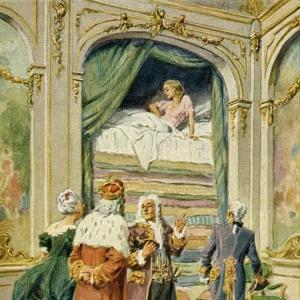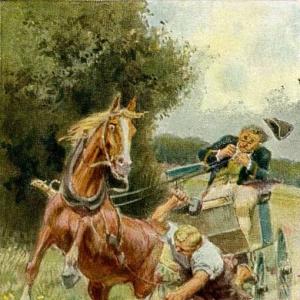Reading time: 9 min
High up in the thin, clear air there flew an angel bearing a flower from the garden of heaven. As he kissed it, a tiny leaf drifted down into the muddy soil in the middle of the wood. It very soon took root there, and sprouted, and sent up shoots among the other plants.
„That’s a funny kind of slip,“ said the plants.
And neither the thistle nor the stinging nettle would have anything to do with the stranger. „It must be some low kind of garden plant,“ they said, grinning and making fun at it. But it grew and grew, and like no other plant its long branches spread far about.
„Where do you think you’re going?“ said the tall thistles, who have thorns on each of their leaves. „You’re taking a good deal of space. That’s a lot of nonsense-we can’t stand here and support you!“
When winter came, the snow covered the plant, but from it the blanket of snow received a glow as if the sun were shining from below. Then the spring returned, and the plant was in glorious bloom, more beautiful than any other in the forest.
And now there came to the forest a professor of botany, who could show what he was with many degrees. He carefully inspected the plant and tested it, but decided it was not included in his system of botany. He could not possibly learn to what class it did belong.
„This must be some unimportant variety,“ he said. „I certainly don’t know it. It’s not included in any system.“
„Not included in any system!“ said the thistles and the nettles.
The big trees which grew round it heard what was said and they also saw the tree was not one of their kind, but they said nothing, good or bad. And that is much the wisest course for stupid people to take.
Then a poor, innocent girl came through the forest. Her heart was pure, and her understanding was glorious with faith. Her only inheritance was an old Bible, but from its pages the voice of God spoke to her: „If people wish to do you evil, remember the story of Joseph. They had evil in their hearts, but God turned it to good. If you suffer wrong, if you are despised and misunderstood, then you must remember the words of Him who was purity and goodness itself, and who prayed for those who struck Him and nailed Him to the cross. ‚Father, forgive them. For they know not what they do!‘ “
She stopped before the wondrous plant, whose great leaves gave forth sweet and refreshing fragrance and whose flowers glowed in the sun like a wonderful firework of color. And from each flower there came a sound as though it held concealed within itself a deep well of melody that thousands of years would not empty. With devout gratitude the girl gazed on this exquisite work of the Creator and bent down one of the branches, that she might examine the flower and breathe in its sweetness; and a lovely light burned in her soul. It seemed to uplift her heart, and she wanted to pluck a flower, but she had not the heart to break one off, for she knew it would soon fade if she did. So she took only a single green leaf, carried it home, and there she pressed it in between the pages of her Bible; and it lay there quite fresh, always green, and never fading.
It was kept in the pages of that Bible, and with that Bible it was placed under the girl’s head when, some weeks thereafter, she lay in her coffin. On her gentle face was the solemn peace of death, as if the earthly remains carried the imprint of the truth that she now was in the presence of her Creator.
But the marvelous plant still bloomed in the forest. It looked almost like a great tree now, and all the birds of passage, especially the storks and the swallows, bowed down before it.
„That thing is taking on foreign airs now,“ said the thistles and the burdocks. „We never act like that here in this country!“
And the black forest snails spat at the plant.
Then the swineherd came, collecting thistles and other shrubs, to burn them for their ashes. He tore up the heavenly plant by the roots and crammed it into his bag.
„I can use that, too,“ he said, and no sooner said than done.
But for years the King of that country had been troubled by a deep melancholy of spirit. He kept busy and laborious always, but it seemed to do him no good. They read books to him-deep and learned tomes, or the lightest and most trifling they could find; but nothing did any good. Then one of the world’s wisest men, to whom they had applied for help, sent a messenger to explain to the King that there was but one sure remedy that would relieve and cure him.
„In a forest in the King’s own country there grows a plant of heavenly origin. Its appearance cannot be mistaken.“ And then the messenger brought out a drawing of the plant. It would be easy to recognize it. „Its leaves are green winter and summer, so every evening put a fresh leaf on the King’s forehead. His thoughts will then clear, and a beautiful dream will refresh and strengthen him.“
„I think I took it up in my bundle and burned it to ashes a long time ago,“ said the swineherd. „I just didn’t know any better.“
„You did not know any better!“ they all said. „Ignorance, oh, ignorance! How great you are!“
And those words the swineherd might well take to heart, for they were meant for him and no one else.
Not a single leaf of that plant could be found. No one knew about the one leaf that lay in the coffin of the dead girl.
And the King himself, in his terrible depression, wandered out to the spot in the woods. „This is where the plant grew,“ he said. „It shall be a sacred place.“ Then he had it surrounded by a golden railing, and a sentry was posted there, by day and by night.
The professor of botany wrote a thesis on the heavenly plant. As a reward he was gilded all over, and that gilding suited him and his family very well indeed. As a matter of fact, that was the pleasantest part of the whole story, for the plant had disappeared.
The King remained as melancholy and sad as before; but then he had always been that way-said the sentry.
 Learn languages. Double-tap on a word.Learn languages in context with Childstories.org and Deepl.com.
Learn languages. Double-tap on a word.Learn languages in context with Childstories.org and Deepl.com.Backgrounds
Interpretations
Adaptions
Summary
Linguistics
„A Leaf from Heaven“ is a fairy tale written by Hans Christian Andersen, a Danish author who is best known for his children’s stories. Born in 1805 and active during the 19th century, Andersen was a prolific writer of poems, novels, travelogues, and plays. However, his fairy tales gained the most recognition and are still beloved by readers today. Some of his most famous works include „The Little Mermaid,“ „The Ugly Duckling,“ „The Emperor’s New Clothes,“ and „The Snow Queen.“
Andersen’s fairy tales often incorporate elements of folklore, fantasy, and moral lessons. They frequently delve into themes such as the power of love, the triumph of good over evil, and the importance of inner beauty. His stories have been translated into numerous languages and have inspired various adaptations, including films, plays, and ballets.
„A Leaf from Heaven“ is not as well-known as some of Andersen’s other works, but it shares many of the same themes and stylistic elements that characterize his other fairy tales. The story’s exploration of faith, nature, human knowledge, and the value of the overlooked showcase Andersen’s ability to craft engaging and thought-provoking narratives that resonate with readers of all ages.
„A Leaf from Heaven“ can be interpreted in various ways, offering insights into themes such as the value of faith, the beauty of nature, and the limits of human knowledge. Here are some interpretations of the story.
The power of faith: The poor girl’s deep faith and pure heart allow her to appreciate the heavenly plant’s beauty and significance. While others fail to recognize its value, she experiences a spiritual connection to the plant. This suggests that faith can help people see and appreciate the divine in the world around them.
The beauty and power of nature: The heavenly plant stands as a symbol of the beauty and power of nature, transcending human understanding. Despite attempts by the other plants and the professor of botany to classify and explain it, the plant remains mysterious and unique. This emphasizes the idea that nature is full of wonders that cannot always be explained or understood by humans.
The limits of human knowledge: The story highlights the limitations of human knowledge, as neither the plants in the forest nor the professor of botany can fully comprehend the heavenly plant’s nature. This serves as a reminder that there are things in the world that are beyond our understanding and that we should approach them with humility and respect.
The consequences of ignorance: The destruction of the heavenly plant by the swineherd showcases the negative consequences of ignorance. He destroys something of great value without realizing its significance, and the King remains in his melancholic state. This serves as a cautionary tale about the importance of respecting and preserving the natural world and its wonders.
The hidden value of the overlooked: The heavenly plant’s miraculous properties remain hidden in the dead girl’s Bible, emphasizing that sometimes the most valuable and powerful things can be found in the most unexpected places. This suggests that people should be more attentive to the overlooked and seemingly insignificant aspects of life, as they might hold the key to happiness and understanding.
There are relatively few adaptations of „A Leaf from Heaven“ compared to other Hans Christian Andersen fairy tales, but here are a few notable examples.
„The Leaf“ (2015): This short film adaptation of the story was produced by the Mormon Channel and features a modern-day setting. The story follows a young boy who finds a withered leaf and wishes for it to be restored to life. Like the original story, the boy embarks on a journey to a magical garden and learns valuable lessons about kindness and compassion.
„A Leaf from Heaven“ (2015): This musical adaptation of the story was produced by the Chongqing Puppet Theater in China. The production features colorful puppetry and traditional Chinese music and dance, and tells the story of a poor boy who embarks on a magical journey to a beautiful garden in the sky.
„A Leaf from Heaven“ (2016): This animated short film adaptation was produced by filmmaker Katya Mikheeva and features a unique visual style inspired by traditional Russian folk art. The story follows a young girl who finds a withered leaf and embarks on a magical journey to a beautiful garden in the sky, where she learns about the power of kindness and compassion.
„The Leaf from Heaven“ (2020): This adaptation of the story was produced by the Chinese film studio Alibaba Pictures and features a modern-day setting. The story follows a young girl who finds a withered leaf and is transported to a magical garden in the sky, where she learns valuable lessons about the power of nature and the importance of protecting the environment. The film features a mix of live-action and CGI animation.
These adaptations of „A Leaf from Heaven“ vary in their approach to the story, but all emphasize the importance of kindness, compassion, and personal growth.
„A Leaf from Heaven“ is a fairy tale by Hans Christian Andersen that tells the story of a heavenly plant that sprouts in a forest after an angel drops a leaf from the Garden of Heaven. The other plants in the forest, such as thistles and nettles, mock the strange plant, and even a professor of botany cannot classify it in his system.
One day, a poor, innocent girl with a pure heart and deep faith comes across the plant. She is captivated by its beauty and fragrance and takes a single green leaf from it, placing it in her Bible. The girl dies a few weeks later, and the leaf is buried with her, remaining evergreen and unfading.
Meanwhile, the King of the country is plagued by melancholy, and a wise man suggests that a leaf from the heavenly plant will cure him. But the plant has been uprooted and destroyed by a swineherd who didn’t know its value. The King, in despair, visits the spot where the plant once stood, declares it sacred, and installs a sentry to guard it day and night. The professor of botany is rewarded for his work on the plant, but the King remains as melancholic as ever, for the plant’s miraculous properties lie forgotten in the dead girl’s Bible.
The fairy tale „A Leaf from Heaven“ by Hans Christian Andersen offers a rich tapestry for linguistic and thematic analysis, showcasing Andersen’s distinctive narrative style and the moral implications characteristic of his work.
Imagery and Metaphor: Andersen’s use of vivid imagery („the flower from the garden of heaven“) and metaphor (the plant as a „wondrous plant,“ „exquisite work of the Creator“) establishes a divine and miraculous tone. This evokes a sense of wonder and reinforces the supernatural origin of the plant.
Symbolism: The heavenly plant symbolizes purity, hope, and divine intervention. Its growth amidst thistles and nettles can be viewed as a metaphor for purity and goodness thriving in a world of cynicism and judgment. The plant’s rejection by both the flora and the learned professor symbolizes societal inability to recognize true value due to prejudice or limited perspective.
Dialogue and Personification: The plants in the story are given voice, which personifies natural elements. This technique highlights the contrast between the mundane and the divine—the quarreling thistles and nettles represent the ordinary mindset, while the plant embodies a higher truth or divine presence that defies mundane understanding.
Irony: Andersen employs irony in his depiction of the professor of botany—despite his extensive knowledge, he fails to recognize the plant’s significance, underscoring the limitations of human knowledge and the superficial nature of societal rewards.
Narrative Voice: The third-person narrative offers detached observations laced with subtle commentary, as seen in phrases like „that is much the wisest course for stupid people to take. “ This narrative style allows Andersen to critique human folly while maintaining the enchantment of the fairy tale.
Thematic Analysis
Ignorance and Knowledge: A central theme is the dichotomy between ignorance and true understanding. The swineherd’s ignorance in destroying the plant highlights the loss of something irreplaceable, while the professor’s scholarly knowledge fails to encompass the plant’s divine nature. Andersen critiques both ignorance and the limitations of academic knowledge.
Divine Intervention and Faith: The story emphasizes the importance of faith and divine intervention. The girl’s reflection on her Bible parables suggests that faith can recognize and preserve divine truth, even when the world does not understand it. The plant’s divine origins and the comfort it brings suggest divine understanding and solace beyond human comprehension.
Materialism vs. Spirituality: The tale contrasts materialistic and spiritual values. The professor and those who focus on quantifiable knowledge and material rewards cannot grasp the plant’s true significance. In contrast, the pure-hearted girl’s interaction with the plant and her subsequent peace in death symbolize a spiritual victory over worldly ignorance.
Critique of Society: Andersen uses various characters to critique societal behaviors—superficiality, materialism, pride in ignorance, and the failure to recognize genuine worth. The King remains melancholic despite the attempts to find solace, illustrating the futility of seeking happiness through external means without deeper understanding or spiritual insight.
In conclusion, Andersen’s „A Leaf from Heaven“ skillfully weaves linguistic elements and themes to create a fairy tale that critiques societal values, celebrates spiritual insight, and underscores the profound connection between faith and the recognition of divine truth.
Information for scientific analysis
Fairy tale statistics | Value |
|---|---|
| Translations | DE, EN, DA, ES, IT |
| Readability Index by Björnsson | 26.9 |
| Flesch-Reading-Ease Index | 82.4 |
| Flesch–Kincaid Grade-Level | 5.6 |
| Gunning Fog Index | 8.6 |
| Coleman–Liau Index | 8.4 |
| SMOG Index | 8.8 |
| Automated Readability Index | 5.6 |
| Character Count | 6.010 |
| Letter Count | 4.613 |
| Sentence Count | 73 |
| Word Count | 1.123 |
| Average Words per Sentence | 15,38 |
| Words with more than 6 letters | 129 |
| Percentage of long words | 11.5% |
| Number of Syllables | 1.445 |
| Average Syllables per Word | 1,29 |
| Words with three Syllables | 68 |
| Percentage Words with three Syllables | 6.1% |

 Facebook
Facebook  Whatsapp
Whatsapp  Messenger
Messenger  Telegram
Telegram Reddit
Reddit














